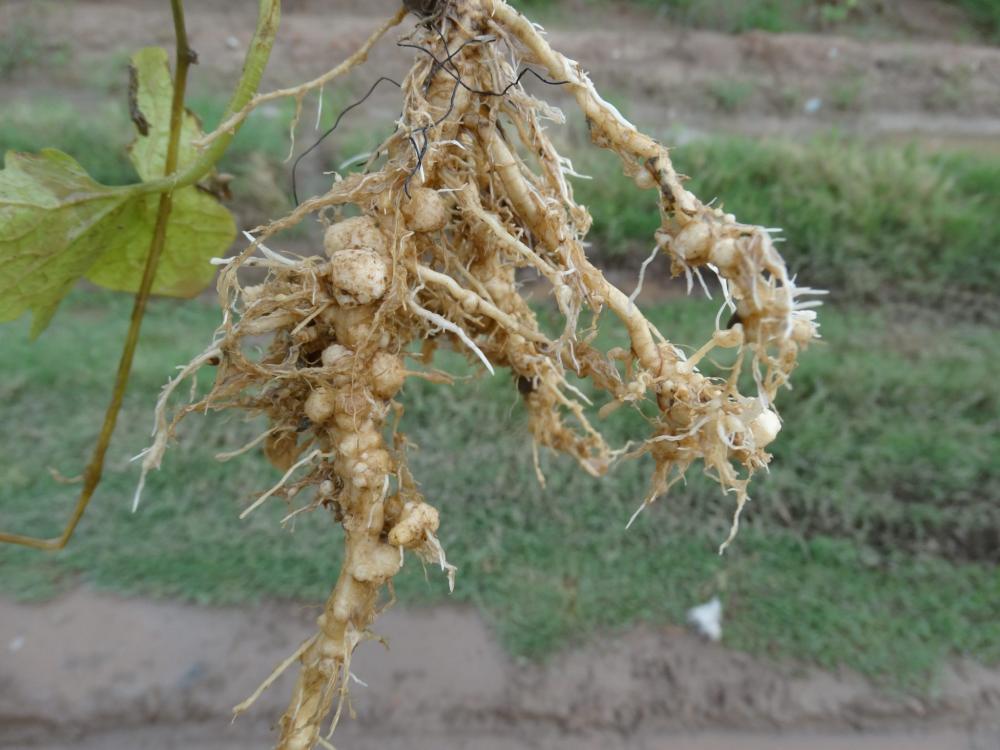
- Nematodes are among the most dangerous pests affecting plant roots, causing stunted growth, yellowing leaves, and a significant decline in productivity. They are considered silent diseases that are difficult to detect in their early stages because they operate beneath the soil surface and gradually weaken the roots. However, they can be managed using integrated preventative and therapeutic methods to reduce losses and preserve the crop.
- Symptoms of nematode infection
- 🌱 The appearance of knots and swellings on the roots.
- 🍂 Yellowing and wilting of leaves despite adequate watering.
- 🌾 Slowing and noticeable stunting in growth.
- 🪵 Ulcers or rot in the roots make them weak and easy to break.
Forms of nematode disease on plants
🟢 Root-knot nematodes:
- The appearance of small bumps or nodules on the roots.
- The roots become deformed and filled with swellings.
- The plant above the soil appears weak, yellow, and delayed in growth.
🟤 Lesion nematodes:
- Brown or black spots and sores on the roots.
- The roots become short, brittle and break easily.
- Plants look wilted even with watering.
🌱 Dwarfing nematodes:
- Dwarfism and obvious smallness in plant size.
- Few leaves and small size.
- General weakness in crop and production.
- • Root rot nematodes:
- Decaying, rotting roots with sometimes a foul odor.
- The plant gradually weakens or slowly dies.
Prevention methods
- 🔄 Crop rotation: planting less sensitive crops such as wheat, corn, barley, and clover.
- 🌞 Solarization: Cover the soil with clear plastic for 4 to 6 weeks to kill eggs and larvae.
- ♻️ Adding organic matter: Improving the soil with compost and decomposed manure to reduce nematode activity.
- 🌱 Use healthy seedlings: free from infection to avoid transmission of infection.
- Active ingredients to combat nematodes
- Abamectin: 1–2 ml per 1 liter of water – repeat every 14 days.
- Oxamyl: 2–3 ml per 1 liter of water – repeat every 21 days.
- Fluopyram: 0.5–1 ml per 1 liter of water – repeated every 30 days.
- Cinnamaldehyde (1.6%): 2–3 liters per acre – repeat every 15 days.
- Fosthiazate (50% W/V): 1–1.5 liters per acre – repeat every 30–40 days.
- Biological control (Trichoderma / Paecilomyces lilacinus): Added to the soil or with irrigation water once every two months.
📉 Economic damages
- Yield decrease of 20–30% in infected lands.
- Small fruit size and poor quality, which reduces the marketing value.
- Increased control costs and difficulty in eliminating them completely.
Important notes
- ⚠️ Nematodes cannot be treated with just one pesticide → The best solution is integrated management (prevention + pesticides + biological control).
- 🌱 The most sensitive crops: tomatoes, potatoes, peppers, watermelons, onions.
- 🌾 Less sensitive crops: wheat, corn, barley, alfalfa.

